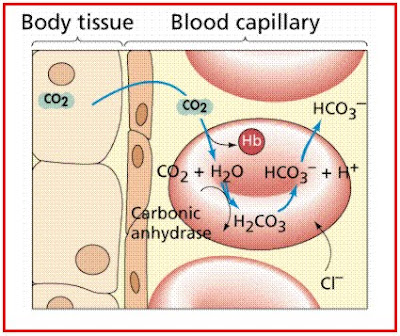1. pertukaran oksigen
Kebutuhan
oksigen setiap individu berbeda-beda tergantung pada umur, aktivitas,
berat badan, jenis kelamin dan jumlah makanan yang dikonsumsi makanan
yang dikonsumsi.
Dalam keadaan biasa jumlah
oksigen yang dibutuhkan sebanyak 300 ml perhari per individu. Sebagian
besar oksigen diangkut oleh hemoglobin dengan reaksi sebagai berikut:
Hb4 + 4 O2 -----> 4 HbO2
Proses
pengikatan dan pelepasan oksigen dipengaruhi oleh tekanan oksigen,
kadar oksigen, kadar carbondioksida dan kadar oksigen dan karbondioksida
di jaringan tubuh dan berjalan secara difusi
 Penjelasan dari segi tekanan dapat dijelaskan sebagai berikut:
Penjelasan dari segi tekanan dapat dijelaskan sebagai berikut:
 Penjelasan dari segi tekanan dapat dijelaskan sebagai berikut:
Penjelasan dari segi tekanan dapat dijelaskan sebagai berikut:
Tekanan
oksigen di udara(PO2=160 mmHg) lebih besar dibanding tekanan oksigen
dalam alveolus (PO2=105mmHg). sedang Tekanan oksigen di arteri 100 mmHg,
tekanan oksigen di jaringan 40 mmHg, tekanan oksigen di vena lebih
kecil 40 mmHg. Jadi tekanan oksigen di udara luar lebih besar tekanan
oksigen di alveolus. Tekanan udara di alveolus lebih besar dibandingkan
tekanan oksigen di arteri. Tekanan oksigen di arteri lebih besar dari
tekanan oksigen di jaringan.
•Berapa cc O2 yang dapat diangkut oleh 5 liter darah, sekali beredar ke seluruh tubuh?
Setiap 100 cc darah di arteri mampu mengangkut 19 ccO2.
Setelah sampai di vena setiap 100 cc darah masih mengandung O2 sebanyak 12 cc Jadi volume O2 yang tertinggal di jaringan adalah 7 cc
•Jika volume darah ada 5 liter, atau 5000 liter, maka volume O2 yang sampai ke jaringan sekali beredar adalah:
•5000 / 100 x 7 cc = 50 x 7 = 350 cc
Setiap 100 cc darah di arteri mampu mengangkut 19 ccO2.
Setelah sampai di vena setiap 100 cc darah masih mengandung O2 sebanyak 12 cc Jadi volume O2 yang tertinggal di jaringan adalah 7 cc
•Jika volume darah ada 5 liter, atau 5000 liter, maka volume O2 yang sampai ke jaringan sekali beredar adalah:
•5000 / 100 x 7 cc = 50 x 7 = 350 cc
2. pertukaran Karbondioksida
P.CO2 di jaringan tubuh = 60 mmHg à P. CO2 di vena = 47 mmHg à P. CO2 di alveolus (PCO2= 35 mmHg) atau luar tubuh = 0.3 mmHg
•Pengangkutan CO2 oleh darah dilakukan 3 cara yaitu:
•Pengangkutan CO2 oleh darah dilakukan 3 cara yaitu:
a. Oleh plasma darah
CO2 + H2O H2CO3
Pengangkutan ini dibantu enzim karbonat anhidrase jumlah CO2 yang dapat di
angkut sebanyak 5 %
CO2 + H2O H2CO3
Pengangkutan ini dibantu enzim karbonat anhidrase jumlah CO2 yang dapat di
angkut sebanyak 5 %
b. Oleh Hemoglobin
CO2 + Hb -----> HbCO2 (Karbominohemoglobin)
CO2 + Hb -----> HbCO2 (Karbominohemoglobin)
c. Pertukaran klorida
- CO2 + H2O -------> HCO3
- H2CO3 -------> H+ dan HCO3
- H+ di ikat Hb, krn bersifat racun dalam sel
- HCO3 --------> ke plasma darah
- HCO3 ---------> diganti oleh Cl-
PERTUKARAN CO2 JARINGAN TUBUH - SEL DARAH ( RESPIRASI INTERNAL)

PERTUKARAN CO2 SEL DARAH - PARU PARU ( RESPIRASI EXTERNAL)

- CO2 + H2O -------> HCO3
- H2CO3 -------> H+ dan HCO3
- H+ di ikat Hb, krn bersifat racun dalam sel
- HCO3 --------> ke plasma darah
- HCO3 ---------> diganti oleh Cl-
PERTUKARAN CO2 JARINGAN TUBUH - SEL DARAH ( RESPIRASI INTERNAL)

PERTUKARAN CO2 SEL DARAH - PARU PARU ( RESPIRASI EXTERNAL)

curve at a normal pH (pH = 7.4).The green line represents the curve in the blood of
exercising tissues, shifted to the right of the normal curve.The black line represents the curve in the blood at the
lungs, shifted to the left of the normal curve.
Permission granted by Domnica Marghescu, Chief Technician, Physiology Department, McGill UniversityHigher PCO2 = Higher [H+] = Lower pH = Shift to the RIGHTLower PCO2 = Lower [H+] = Higher pH = Shift to the LEFT





0 komentar:
Posting Komentar